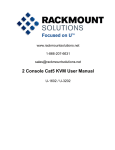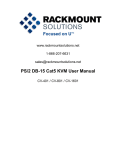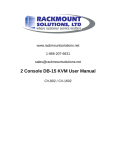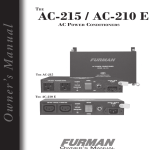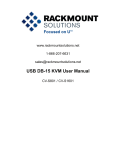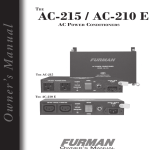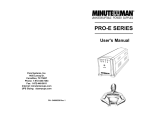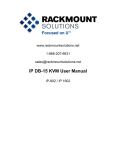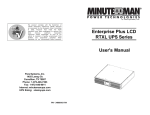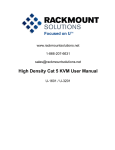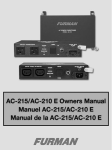Download Rackmount Solutions E1500RM1U User's Manual
Transcript
1-866-207-6631 | www.rackmountsolutions.net [email protected] English Enterprise 1U Rackmount Series User's Manual 1. Introduction 2 2. Controls and Indicators 6 3. Installation 8 4. Operation 12 5. Troubleshooting 15 6. Replacing the Battery 16 7. Obtaining Service 19 8. Specifications 20 9. Configurable Parameters & Settings 22 10. Limited Product Warranty 23 11. Declaration of Conformity 25 © Copyright Para Systems, Inc., 2005 1 English Thank you for purchasing a MINUTEMAN power protection product. It has been designed and manufactured to provide many years of trouble free service. IMPORTANT SAFETY INSTRUCTIONS SAVE THESE INSTRUCTIONS ! Please read this manual before installing your Enterprise 1U Rackmount Series UPS, models E700RM1U, E1000RM1U, E1500RM1U, as it provides important information that should be followed during installation and maintenance of the UPS and batteries allowing you to correctly set up your system for the maximum safety and performance. Included is information on customer support and factory service if it is required. If you experience a problem with the UPS please refer to the Troubleshooting guide in this manual to correct the problem or collect enough information so that the MINUTEMAN Technical Support Department can rapidly assist you. This symbol indicates "ATTENTION" This symbol indicates "Risk of Electrical Shock" This symbol indicates "Alternating Current Supply Phase" This symbol indicates "Alternating Current Supply" 2 This symbol indicates "Equipment Grounding Conductor" CAUTION! Connect the UPS to a two pole, three wire grounding AC wall outlet. The receptacle must be connected to the appropriate branch protection (circuit breaker or fuse). Connection to any other type of receptacle may result in a shock hazard and violate local electrical codes. Do not use extension cords, adapter plugs, or surge strips. CAUTION! To reduce the risk of electrical shock with the installation of this UPS equipment and the connected equipment, the user must ensure that the combined sum of the AC leakage current does not exceed 3.5mA. CAUTION! To reduce the risk of electrical shock in conditions where the load equipment grounding cannot be verified, disconnect the UPS from the AC wall outlet before installing a computer interface cable. Reconnect the power cord only after all signaling connections are made. WARNING: This Uninterruptible Power Supply contains potentially hazardous voltages. Do not attempt to disassemble the UPS beyond the battery replacement procedure. This UPS contains no user serviceable parts. Repairs and Battery replacement must be performed by QUALIFIED SERVICE PERSONNEL ONLY. WARNING: Risk of Electrical Shock. Hazardous live parts inside these power supplies are energized from the battery even when the AC input is disconnected. CAUTION! To de-energize the outputs of the UPS: 1. If the UPS is on press and release the On/Off/Test button. 2. Disconnect the UPS from the AC wall outlet. 3. To de-energize the UPS completely, disconnect the battery. 3 English This symbol indicates "Direct Current Supply" English NOTICE: This equipment has been tested and found to comply with the limits for a Class A computing device in accordance with the specifications in Subpart J of Part 15 of FCC Rules and the Class A limits for radio noise emissions from digital apparatus set out in the Radio Interference of the Canadian Department of Communications. These limits are designed to provide reasonable protection against such interference in a residential installation. This equipment generates and uses radio frequency and if not installed and used properly, that is, in strict accordance with the manufacturer's instructions, this equipment may cause interference to radio and television reception. If this equipment does cause interference to radio or television reception, which can be determined by turning the equipment off and on, the user is encouraged to try to correct the interference by one or more of the following measures: Re-orient the receiving antenna. Relocate the computer with respect to the receiver. Move the computer away from the receiver. Plug the computer into a different outlet so that the computer and receiver are on different branch circuits. Shielded communications interface cables must be used with this product. WARNING: Changes or modifications to this unit not expressly approved by the party responsible for compliance could void the user's authority to operate the equipment. Receiving Inspection After removing your MINUTEMAN UPS from its carton, it should be inspected for damage that may have occurred in shipping. Immediately notify the carrier and place of purchase if any damage is found. Warranty claims for damage caused by the carrier will not be honored. The packing materials that your UPS was shipped in are carefully designed to minimize any shipping damage. In the unlikely case that the UPS needs to be returned to MINUTEMAN, please use the original packing material. Since MINUTEMAN is not responsible for shipping damage incurred when the system is returned, the original packing material is inexpensive insurance. PLEASE SAVE THE PACKING MATERIALS! NOTE: These UPSs are shipped with the batteries disconnected. The batteries must be connected before putting these UPSs into service. Refer to Section 3 "Installation" for connecting the batteries. 4 As a general policy, Para Systems Inc. (Para Systems) does not recommend the use of any of its products in life support applications where failure or malfunction of the Para Systems product can be reasonably expected to cause failure of the life support device or to significantly affect its safety or effectiveness. Para Systems does not recommend the use of any of its products in direct patient care. Para Systems will not knowingly sell its products for use in such applications unless it receives in writing assurances satisfactory to Para Systems that (a) the risks of injury or damage have been minimized, (b) the customer assumes all such risks, and (c) the liability of Para Systems Inc. is adequately protected under the circumstances. Examples of devices considered to be life support devices are neonatal oxygen analyzers, nerve stimulators (whether used for anesthesia, pain relief, or other purposes), auto transfusion devices, blood pumps, defibrillators, arrhythmia detectors and alarms, pacemakers, hemodialysis systems, peritoneal dialysis systems, neonatal ventilator incubators, ventilators for both adults and infants, anesthesia ventilators, and infusion pumps as well as any other devices designated as “critical” by the United States FDA. Hospital grade wiring devices and leakage current may be ordered as options on many PARA SYSTEMS UPS systems. PARA SYSTEMS does not claim that units with this modification are certified or listed as Hospital Grade by PARA SYSTEMS or any other organization. Therefore, these units do not meet the requirements for use in direct patient care. 5 English Para Systems Life Support Policy English CONTROL PANEL The AC normal (green) LED illuminates in a steady state when the UPS is on and operating in the AC normal mode. The AC normal LED will extinguish when operating in the Battery mode. The On-Battery (green) LED illuminates in a steady state when the UPS is operating in the Battery mode. The On-Battery LED will extinguish when operating in the AC normal, Boost and Buck modes. The Boost (yellow) LED illuminates in a blinking state when the UPS is operating in the Boost mode. The Boost LED will extinguish when operating in the AC normal, Buck and Battery modes. The Buck (yellow) LED illuminates in a blinking state when the UPS is operating in the Buck mode. The Buck LED will extinguish when operating in the AC normal, Boost and Battery modes. The Fault (red) LED illuminates in a steady state when the UPS detects an internal fault. The Fault LED is extinguished when the UPS is operating properly. The Weak/Bad Battery (red) LED illuminates in a steady state when the UPS detects a weak battery, bad battery or if the battery is disconnected. The Weak/Bad Battery LED is extinguished when the battery's condition is good. The Site Wiring Fault (red) LED illuminates in a steady state when the UPS detects a site wiring problem. The Site Wiring Fault LED is extinguished when the UPS is connected to proper site wiring. 6 The Battery Capacity Bar Graph operates as follows: LED #90: >90% battery capacity (red/yellow) LED will be yellow and illuminated until the battery’s capacity drops below 80% capacity and then it will extinguish. LED #70: >70% battery capacity (green/yellow) LED will be yellow and illuminated until the battery’s capacity drops below 60% capacity and then it will extinguish. LED #50: >50% battery capacity (green/yellow) LED will be yellow and illuminated until the battery’s capacity drops below 40% capacity and then it will extinguish. LED #30: >30% battery capacity (green/red/yellow) LED will be yellow and illuminated until the battery’s capacity drops below 30% capacity and then it will turn red. When the battery capacity drops below 20% capacity the LED will extinguish. LED #10: >30% battery capacity (green/red/yellow) LED will be yellow and illuminated until the unit issues a Low Battery Warning Alarm and then it will turn red to indicate a Low Battery Warning. The Multi-Function On/Off/Test Button functions as follows: When the UPS is Off, press and release the On/Off/Test button after one beep to turn the UPS On. When the UPS is On, press and release the On/Off/Test Button after one beep to turn the UPS Off. When the UPS is On, press and hold the On/Off/Test button for four beeps, then release the button. The UPS will perform a 5-second Self Test. 7 English The Load Level Bar Graph operates as follows: LED #10: >10% load (green/red/yellow) LED will be green and illuminated when there is at least 10% of the rated capacity. LED #30: >30% load (green/yellow) LED will be green and illuminated when there is at least 30% of the rated capacity. LED #50: >50% load (green/yellow) LED will be green and illuminated when there is at least 50% of the rated capacity. LED #70: >70% load (green/yellow) LED will be green and illuminated when there is at least 70% of the rated capacity. LED #90: >90% to approximately 109% load (red/yellow) LED will be yellow and illuminated when there is approximately 90% of the rated capacity to indicate that unit is near full capacity. The LED will turn red at 110% load capacity to indicate an Overload condition. REAR PANEL English 1. The input power cord has a NEMA 5-15P Plug. 2. The input circuit breaker will trip in the event the load exceeds the UPS’s power rating. 3. The Battery Backup output power receptacles are NEMA 5-15R type. The output receptacles are electrically wired into two segments to support the "Load Shedding Function". The three receptacles on the left are Segment 1 and the three receptacles on the right are Segment 2. 4. The RS232 Communications Interface Port is for UPS monitoring and control. 5. The R-J11/R-J45 modular connectors are used for 10/100 Base-T Network/ single line Phone/Fax/Modem protection. 6. The USB Communications Interface Port is for UPS monitoring and control. 7. The Dipswitches are for setting the Inverter (On-Battery) output voltage. 8. The option slot will support MINUTEMAN option cards only. INSTALLATION PLACEMENT The Enterprise 1U Rackmount Series is intended to be install in a temperature controlled environment that is free of conductive contaminants. Select a location which will provide good air circulation for the UPS at all times. Avoid locations near heating devices, water or excessive humidity, or where the UPS is exposed to direct sunlight. Route power cords so they cannot be walked on or damaged. Operating Temperature (Maximum): 0 to 40 degrees C (+32 to 104 degrees F) Operating Elevation: 0 to 3,000m (0 to 10,000 ft) Operating and Storage Relative Humidity: 95%, non-condensing Storage Temperature: -15 to +45 degrees C (+5 to +113 degrees F) Storage Elevation: 0 to 15,000m (0 to +50,000 ft) 8 Be sure to read the installation placement and all the cautions before installing the UPS. Place the UPS in the final desired location and complete the rest of the installation procedure. These UPSs are shipped with the internal batteries disconnected. The batteries must be connected before putting these UPSs into service. Follow the procedure below to connect the batteries and install the UPS into the rack. USE CAUTION: The UPS is heavy. Use the appropriate number of personnel when installing the UPS. Connecting the Batteries 1. Remove the UPS from the shipping box and set on the floor or a bench top. 2. Grasp the front panel and gently pull it off the UPS. (FIG. 1) 3. Remove the four retaining screws for the battery retaining bracket. (FIG. 2) 4. Remove the battery retaining bracket. (FIG. 2) 5. Grasp the battery tray and gently pull the battery tray out far enough to get to the battery connectors (red and black). (FIG. 3) 6. Connect the battery connectors (red and black) together. 7. Gently slide the battery tray back into the UPS. 8. Re-install the battery retaining bracket. 9. Re-install the four retaining screws for the battery retaining bracket. 10. Re-install the front panel onto the UPS. FIG. 2 FIG. 1 FIG. 3 9 English INSTALLATION Installing the UPS in a 4-post rack English USE CAUTION: The UPS is heavy. Use the appropriate number of personnel when installing the UPS. 1. Install the rails in the 4-post rack. (FIG. 1) 2. Install the rack ears on the UPS. (FIG. 2) 3. Align the cleats with the rails and slide the UPS into the rails. (FIG. 3) NOTE: The cleats are pre-mounted on the UPS. 4. Secure the UPS to the rack with the retaining screws (not provided). The UPS is ready for normal operation, see connecting your equipment. Installing the UPS in a 2-post rack USE CAUTION: The UPS is heavy. Use the appropriate number of personnel when installing the UPS. MINUTEMAN recommends that the UPS be installed at the bottom of the rack and that the rack ears be installed as FIG. 4. 1. Install the rack ears on the UPS. (FIG. 4) NOTE: If you are installing the rack ears in the middle of the UPS, the premounted cleats will have to be removed from the UPS. 2. Secure the UPS to the rack with the retaining screws (not provided). The UPS is ready for normal operation; see connecting your equipment. FIG. 1 FIG. 3 10 FIG. 2 FIG. 4 Plug the equipment into the output receptacles on the rear panel of the UPS. Do not use extension cords, adapter plugs or surge strips on the output of the UPS. Ensure that you do not exceed the maximum output rating of the UPS (refer to the information label on the UPS or the Electrical Specifications in this manual). CAUTION! DO NOT connect a laser printer to the output receptacles on the UPS, unless the UPS is rated 2000VA or greater. A laser printer draws significantly more power when printing than at idle and may overload the UPS. CONNECTING THE UPS TO AN AC SOURCE Plug the UPS into a two pole, three wire, grounded receptacle only. Do not use extension cords, adapter plugs, or surge strips. CHECKING THE SITE WIRING FAULT After plugging in the UPS, check the Site Wiring Fault (SWF) LED on the control panel of the UPS. If the SWF LED is illuminated, the UPS is plugged into an improperly wired AC outlet. If the UPS indicates a Site Wiring Fault (SWF), have a Qualified Electrician correct the problem. CHARGING THE BATTERY The Enterprise 1U Rackmount Series UPS will charge the internal batteries whenever the UPS is connected to an AC source. It is recommended that the UPS's batteries be charged for a minimum of 4 hours before use. The UPS may be used immediately, however, the “On-Battery” runtime may be less than normally expected. NOTE: If the UPS is going to be out of service or stored for a prolonged period of time, the batteries must be recharged for at least twentyfour hours every ninety days. COMMUNICATIONS PORT CONNECTION (OPTIONAL) MINUTEMAN Power Monitoring Software and interface cables kits can be used with the Enterprise 1U Rackmount Series UPS. Use only MINUTEMAN or MINUTEMAN approved interface cables with these UPSs. Connect the interface cable (Serial or USB) to the appropriate communications port on the rear panel of the UPS. Connect the other end of the cable to the device that will be monitoring/controlling the UPS. NOTE: Connecting to the Communications Port is optional. The UPS works properly without this connection. NETWORK/PHONE/FAX/MODEM PROTECTION CONNECTION (OPTIONAL) Connect a 10/100 Base-T network, single line phone, Fax or Modem line to the RJ11/45 protection sockets on the rear panel of the UPS. This connection will require another length of telephone or network cable. The cable coming from the telephone service or networked system is connected to the port marked “IN”. The equipment to be protected is connected to the port marked "OUT". NOTE: Connecting to the Network/Phone/Fax/Modem protection socket connection is optional. The UPS works properly without this connection. 11 English CONNECTING YOUR EQUIPMENT English SYSTEM OVERVIEW This Line-Interactive 1U Rackmount model UPS protects internetworking and telecommunications equipment from blackouts, brownouts, overvoltages, and surges. The AVR function continuously corrects the voltages, in-between the brownout and overvoltage transfer points (85 - 150VAC), to a safe usable level. When the UPS is operating in the AVR mode the audible alarm will remain silent and the Boost or the Buck indicator will blink. During normal AC operation, the MINUTEMAN UPS will quietly and confidently protect your system from power anomalies. The UPS will charge the batteries with the UPS in the on or off position as long as the UPS is plugged into the wall outlet and there is an acceptable AC voltage present. When a blackout, brownout, or an overvoltage condition occurs; the UPS will transfer to the battery mode, the On-Battery indicator will illuminate and the audible alarm will sound once every ten-seconds indicating that the commercial power is lost or unacceptable. When the commercial power returns or is at an acceptable level, the UPS will automatically transfer back to the AC normal mode and start recharging the batteries. During an extended outage when there is approximately two-minutes of backup time remaining the audible alarm will sound twice every five-seconds. This Low Battery Warning is letting the user know that they should save all open files and turn off their computer. When the batteries reach the pre-determined level the UPS will automatically shutdown protecting the batteries from over discharging. Once the commercial power returns the UPS will automatically restart, providing safe usable power to the connected equipment and start recharging the batteries. TURNING THE UNIT ON/OFF On / Off / Test Button Press and release the On/Off/Test Button after one beep to turn the UPS on and supply power to the load. The load is immediately powered while the UPS runs a five-second self test. Press and release the On/Off/Test Button after one beep to turn the UPS off. The UPS will continue to charge the batteries whenever it is plugged into a wall outlet and there is AC present. 12 DIP SWITCH SETTINGS The DIP Switch setting may be changed by the user to set the desired Inverter (On-Battery) output voltage. The DIP Switch must be set to the desired Inverter (On-Battery) output voltage and then the UPS must be turned off and restarted to reconfigure the microprocessor and save the changes. The Inverter (OnBattery) output voltage setting can be either 120VAC (default) or 127VAC. Changing the Inverter (On-Battery) output voltage to 127VAC, will also change the Buck setpoint from 130VAC (default) to 137VAC. Inverter (On-Battery)output voltage Switch 1 2 120V (Off) (On) 127V (On) (Off) LOAD SHEDDING FUNCTION The output receptacles are electrically wired into two segments to support the "Load Shedding Function". The user can control the two segments individually or both at the same time. The Load Shedding Function is controllable by the Power Monitoring Software or the SNMP card. ALARMS ON BATTERY When the UPS is operating on the batteries, the On-Battery LED will illuminate and the audible alarm will sound once every ten-seconds. The alarm will stop once the UPS returns to the AC normal mode. LOW BATTERY WARNING The UPS will sound two beeps every five-seconds when the battery reserve runs low. This condition will continue until AC returns or the UPS shuts down from battery exhaustion. UPS FAULT When the UPS detects a hardware fault, the Fault LED will illuminate and the UPS will sound a constant alarm. The fault condition, in some instances, may be reset by turning the UPS off and then on. 13 English SELF TEST The self test feature is useful to verify the correct operation of the UPS and the condition of the batteries. With the UPS in the AC normal mode, press and hold the On/Off/Test Button for four beeps, then release the button. The UPS will perform a ten-second self test. During the self test, the UPS will switch to battery power and the On-Battery LED will illuminate and the audible alarm will sound. The length of the test that is automatically performed every two weeks is longer than the start-up or user invoked test. This test will run for approximately fifteen-seconds to measure the battery’s capability to provide an acceptable amount of runtime. If the UPS fails a self test, one of the LEDs will remain illuminated indicating the type of problem. NOTE: The UPS will automatically perform a self test on start-up and every two weeks. English OVERLOAD When the amount of load attached to the UPS exceeds its power rating, the Overload LED will illuminate and the UPS will sound a constant alarm. This alarm will remain on until the excess load is removed or the UPS’s self protection circuit shuts the UPS down. WEAK/BAD BATTERY The UPS automatically tests the battery’s condition and will illuminate the Weak/ Bad Battery LED and sound the alarm. This alarm will be repeated until the batteries pass a self test. If the battery is weak, bad or disconnected, the Weak/Bad Battery LED will illuminate and the alarm will beep three times every five-minutes until the battery is reconnected or replaced. It is recommended that the UPS be allowed to charge overnight before performing a battery test to confirm a Weak/Bad Battery condition. NOTE: If the UPS has a Weak/Bad Battery Alarm after reconnecting or replacing the batteries, the user must initiate a self test to clear the Weak/Bad Battery Alarm. To initiate a self test see section 4 "SELF TEST". COMMUNICATIONS PORTS (RS232 and USB) The RS232 communication port is a standard DB9 female with both RS232 and simulated contact closure capability. The Enterprise 1U Rackmount Series UPS will poll the port and activate the port for RS232 or contact closure in accordance with the type of cable it finds connected to the port. To change the port configuration requires the unit be turned off and restarted with the desired cable connected. The pinout for the port is depicted per the chart below. Pin 1: EPO Emergency Power Off (momentarily pull this pin low to completely turn off the UPS in any mode. The UPS will have to be turned off and then turned back on to restart the unit) Pin 2: /TXD Pin 3: /RXD and receive UPS shutdown command Pin 4: Simulated contact closure AC fail, NO Pin 5: Ground Pin 6: Simulated contact closure Low Battery Warning, NO Pin 7: Simulated contact closure AC fail, NC Pin 8: AC fail signal (high to low signal) Pin 9: Not Used USB PORT The USB port will support the MINUTEMAN Power Monitoring Software. See the software CD for the USB installation. POWER MONITORING SOFTWARE The UPS comes with a MINUTEMAN Power Monitoring Software CD. See the software CD for the installation of the MINUTEMAN Power Monitoring Software. OPTION SLOT The option slot on the rear panel of the UPS will only support the MINUTEMAN option cards. 14 English Symptom Possible Cause UPS will not turn on On/Off/Test button not pushed UPS operates in Input AC circuit breaker is battery mode only, tripped even though there is normal AC present Fault LED is illuminated Site Wiring Fault LED is illuminated The AC normal LED is illuminated, but there is no output UPS has detected an internal fault Incorrect service wiring UPS does not provide expected runtime The batteries may be weak or at the end of useful service life The UPS is being controlled via its communications port Weak/Bad Battery Weak/bad batteries or bad LED is illuminated connections at the battery UPS occasionally Normal operation emits a beep Overload LED is The load has exceeded the illuminated and a UPS's capacity constant alarm The Boost LED or The UPS is in either the Buck LED is blink- Boost mode or the Buck mode ing. What To Do Press and release the On/Off/ Test button to start UPS Reset circuit breaker by pressing the plunger back in. If the AC circuit breaker trips after UPS starts up, reduce the load on the UPS Call for service Have a Qualified Electrician correct the service wiring Disconnect the computer cable from the UPS and press the On button. If UPS works normally, the software has control of the UPS Charge the batteries for 8 hours and retest. If the runtime is still less than expected, the batteries may need to be replaced, even though the Weak/Bad Battery LED is not illuminated Check battery connections, charge the batteries for 8 hours, replace the batteries The UPS is performing its intended function Check the specifications (see section 8). Remove part of the load The UPS is performing its intended function 15 English REPLACING THE BATTERY (QUALIFIED SERVICE PERSONNEL ONLY) The Enterprise 1U Rackmount Series UPS has an easy to replace hot-swappable batteries. Please read all of the WARNINGS and CAUTIONS before attempting to service the batteries. NOTE: If there is a power interruption while replacing the hot-swappable batteries, with the UPS on, the load will not be backed up. WARNING! This Uninterruptible Power Supply contains potentially hazardous voltages. Do not attempt to disassemble the UPS beyond the battery replacement procedure. This UPS contains no user serviceable parts. Repairs and Battery replacement must be performed by QUALIFIED SERVICE PERSONNEL ONLY. CAUTION: Do not open or mutilate batteries. Released electrolyte is harmful to the skin and eyes and may be toxic. CAUTION: Do not dispose of batteries in a fire. The batteries may explode. The batteries in this UPS are recyclable. Dispose of the batteries properly. The batteries contain lead and pose a hazard to the environment and human health if not disposed of properly. Refer to local codes for proper disposal requirements or return the battery to MINUTEMAN. CAUTION: Although battery system voltages are only 24VDC the battery system can still present a risk of electrical shock. These batteries produce sufficient current to burn wire or tools very rapidly, producing molten metal. Observe these precautions when replacing the batteries: 1. Remove watches, rings, or other metal objects. 2. Use hand tools with insulated handles. 3. Wear protective eye gear (goggles), rubber gloves and boots. 4. Do not lay tools or other metal parts on top of batteries. 5. Disconnect the charging source prior to connecting or disconnecting the battery terminals. 6. Determine if the battery is inadvertently grounded. If the battery is, remove the source of the grounding. Contact with any part of a grounded battery can result in an electrical shock. The likelihood of such shock will be reduced, if such grounds are removed during installation and maintenance. 16 Model # Battery Qty/Rating EPOWER Part # Panasonic Part # CSB Part # Yuasa Part # E700RM1U E1000RM1U E1500RM1U 4-6V9Ah 4-6V9Ah 4-6V9Ah HR9-6 HR9-6 HR9-6 UP-RW0645Ch1 UP-RW0645Ch1 UP-RW0645Ch1 HRL634WF2FR HRL634WF2FR HRL634WF2FR VALA NPW 45-6 VALA NPW 45-6 VALA NPW 45-6 BATTERY REPLACEMENT PROCEDURE PLEASE READ THE CAUTIONS AND WARNINGS BEFORE ATTEMPTING TO REPLACE THE BATTERIES Hot-swappable batteries mean that the batteries can be replaced without powering down the whole UPS system. NOTE: If there is a power interruption while replacing the hot-swappable batteries, with the UPS on, the load will not be backed up. To hot-swap the batteries start with step number 6. 1. Turn off the equipment that is plugged into the output receptacles of the UPS. 2. Press and release the On/Off/Test button on the front panel to turn the UPS OFF. 3. Unplug the UPS's AC power cord from the AC wall outlet. 4. Unplug the equipment from the output receptacles of the UPS. 5. Unplug the computer interface cable from the rear panel of the UPS. 6. Grasp the front panel and gently pull the front panel off the UPS. (FIG. 2) 7. Lay the front panel on top of the UPS. FIG. 1 FIG. 2 17 English CAUTION: Replace batteries with the same number and type as originally installed in the UPS. These batteries have pressure operated vents. These UPSs contain sealed non-spillable lead acid batteries. English 8. Remove the four retaining screws for the battery retaining bracket. (FIG. 3) 9. Remove the battery retaining bracket. (FIG. 3) 10. Grasp the battery tray and gently pull the battery tray out far enough to get to the battery connectors (red and black). (FIG. 4) 11. Disconnect the battery connectors (red and black). (FIG. 5) 12. Gently remove the battery tray from the UPS and set on the floor. NOTE: Use Caution, the battery tray is heavy. 13. Remove the battery jumper wires. 14. Remove the old batteries from the battery tray. 15. Install the new batteries into the battery tray in the same position as the original batteries. 16. Verify proper polarity. Re-install the battery jumper wires on the new batteries. 17. Slide the battery tray into the UPS. 18. Verify proper polarity. Re-connect the battery connectors (red and black). NOTE: Some sparking might occur, this is normal. 19. Re-install the battery retaining bracket. 20. Re-install the four retaining screws for the battery retaining bracket. 21. Re-install the front panel on the UPS. 22. Properly dispose of the old batteries at an appropriate recycling facility or return them to the supplier in the packing material for the new batteries. 23. The UPS is now ready for the normal start-up operation. NOTE: If the UPS has a Weak/Bad Battery Alarm after replacing the batteries, the user must initiate a self test to clear the Weak/Bad Battery Alarm. To initiate a self test see section 4 "SELF TEST". FIG. 4 FIG. 3 FIG. 5 18 English IF THE UPS REQUIRES SERVICE 1.Use the TROUBLESHOOTING section to eliminate obvious causes. 2.Verify there are no circuit breakers tripped. A tripped circuit breaker is the most common problem. 3.Call your dealer for assistance. If you cannot reach your dealer, or if they cannot resolve the problem call or fax MINUTEMAN Technical Support at the following numbers; Voice phone (972) 446-7363, FAX line (972) 446-9011 or visit our Web site at www.minutemanups.com the "Discussion Board". Please have the following information available BEFORE calling the Technical Support Department. A. Your name and address. B. Where and when the unit was purchased. C. All of the model information about your UPS. D. Any information on the failure, including LEDs that may be illuminated. E. A description of the protected equipment, including model numbers if possible. F. A technician will ask you for the above information and, if possible, help solve your problem over the phone. In the event that the unit requires factory service, the technician will issue you a Return Material Authorization Number (RMA #). G. If the UPS is under warranty, the repairs will be done at no charge. If not, there will be a charge for repair. 4. Pack the UPS in its original packaging. If the original packaging is no longer available, ask the Technical Support Technician about obtaining a new set. It is important to pack the UPS properly in order to avoid damage in transit. Never use Styrofoam beads for a packing material. A. Include a letter with your name, address, day time phone number, RMA number, a copy of your original sales receipt, and a brief description of the problem. 5. Mark the RMA # on the outside of all packages. The factory cannot accept any package without the RMA # marked on the outside. 6. Return the UPS by insured, prepaid carrier to: Para Systems Inc. MINUTEMAN UPS 1455 LeMay Drive Carrollton, TX 75007 ATTN: RMA # _______ 19 English SYSTEM SPECIFICATIONS E700RM1U Model Number E1000RM1U E1500RM1U Line-Interactive, Sine Wave Topology Maximum Power Capacity 1000VA 700W 700VA 490W 1500VA 900W INPUT Number of Phase Single (1∅ 2W +G) Nominal Voltage 120VAC Acceptable Input voltage 0 - 165VAC Voltage Range 85 - 150VAC Frequency Limits 50 or 60 Hz, +/-6Hz, autosensing Low Voltage Transfer Point 85V resets to Utility Power at 90V or higher High Voltage Transfer Point 150V resets to Utility Power at 145V or lower Input Protection Resettable Circuit Breaker OUTPUT NON-BATTERY OPERATION Voltage Range 120VAC: 105 - 132VAC (127VAC: 105 - 137VAC) Voltage Regulation 120VAC: -12.5% - +10% (127VAC: -17.3% - +7.8%) Frequency Range 60Hz: 54 - 66Hz or 50Hz: 44 - 56Hz Efficiency (Line Mode) >93% (Full Load) OUTPUT BATTERY OPERATION Waveform Type Sine Wave Nominal Voltage Default 120VAC User selectable 120/127VAC Voltage Regulation Frequency Nominal +/-2% (until Low Battery Warning) 50/60Hz, +/-0.1Hz (unless synchronized to utility) Voltage T.H.D. <5% (Linear Load) Dynamic Response +/-5% @ 100% Load change in 100mS Transfer Time 2-6 mS Typical Slew Rate <1Hz/Second Overload Capacity Protection 20 <8% (Linear Load) 110% for 20-Seconds 125% for 10-Seconds 150% Shutdown Immediately Over-Current, Short-Circuit Protected and Latching Shutdown BATTERY SYSTEM Battery Type Typical Recharge Time 8 hours from total discharge Typical Battery Life 3-5 years, depending on discharge cycles and ambient temp System Voltage 24VDC 24VDC Battery Quantity/Rating 24VDC 4-6V9Ah 4-6V9Ah 4-6V9Ah Runtime: Half Load 13-Minutes 9-Minutes 7-Minutes Runtime: Full Load 6-Minutes 4-Minutes 3-Minutes SURGE PROTECTION AND FILTERING 800 J Surge energy rating 6500 Amps total Surge current capability Surge response time 0 ns (instantaneous) normal mode; <5 ns common mode Surge voltage let-through (as a percentage of an applied ANSI C62.41 Cat. A +/-6 kV) <5% 10/100 Base-T surge protection let-through (as a percentage of an applied +/-6 kV 1.2/ 50 us, 500 a 8/20 uS test) <5% Telephone line surge protection let-through (as a percentage of an applied +/-6 kV 1.2/ 50 us, 500a 8/20 uS test) <1% Noise filter Normal and common mode EMI/RFI suppression <45 dBA Audible noise at 1 m (3 ft.) ENVIRONMENTAL Operating Temperature (max) 0 to 40°C (+32 to 104°F) Storage Temperature -15 to +45°C (+5 to +113°F) 95% Non-Condensing Operating/Storage Humidity Operating Elevation Storage Elevation 0 to 3,000m (0 to 10,000 ft) 0 to 15,000m (0 to +50,000 ft) PHYSICAL Size - Net HXDXW Weight - Net 1.75 x 24 x 17" 44.5 x 610 x 432 mm 42.3 lb 19.2 Kg 51.2 lb 23.2 Kg 5.2 x 27.6 x 20.9" 132 x 701 x 531 mm Size - Shipping HXDXW Weight - Shipping 51.2 lb 23.2 Kg 52 lb 23.6 Kg 61 lb 27.7 Kg 61 lb 27.7 Kg REGULATORY COMPLIANCE Safety and approvals EMC Verification UL1778, cUL (CSA 22.2 no. 107.1) FCC Class A, CE certified 21 English Sealed, Non-Spillable, Maintenance Free, Value Regulated Lead Acid English (These items may require optional software or hardware) User Choices Factory Default UPS ID Enterprise 1U Up to 64 RM Series characters to define the UPS Date of battery Battery Date of manufacture replacement install month/day/year date XX/XX/XXXX Up to 5 Battery 1826 characters life in days Function Description Use this function to uniquely identify the UPS in your network configuration Enter the current date when replacing batteries At first battery replacement, reset to reflect actual number of days experience in your environment or leave factory default When enabled, the UPS will automatically restart from a low battery shutdown when normal AC returns Enable/ Disable auto restart Enabled Enable or Disable Set audible alarm state Enabled Enabled, at low battery, disabled Enabled - the UPS will emit a short beep when in the battery mode. At Low Battery the UPS will emit two beeps from low battery warning until shutdown. Disabled - Use only when software is controlling the UPS or to silence the alarm Shutdown Type Entire UPS Entire UPS or UPS output Entire UPS - Turns off the entire UPS. UPS Output - Turns off the UPS's output receptacles only. Set inverter output voltage 120VAC 120, 127VAC Changes output voltage for battery mode operation Enable/ Disable EPO Disabled Enable or Disable Enabled - the UPS will be completely powered off and remain off until the UPS is reset 22 English Para Systems Inc. (Para Systems) warrants this equipment, when properly applied and operated within specified conditions, against faulty materials or workmanship for a period of three years from the date of purchase. For equipment sites within the United States and Canada, this warranty covers repair or replacement of defective equipment at the discretion of Para Systems. Repair will be from the nearest authorized service center. Replacement parts and warranty labor will be borne by Para Systems. For equipment located outside of the United States and Canada, Para Systems only covers faulty parts. Para Systems products repaired or replaced pursuant to this warranty shall be warranted for the unexpired portion of the warranty applying to the original product. This warranty applies only to the original purchaser who must have properly registered the product within 10 days of purchase. The warranty shall be void if (a) the equipment is damaged by the customer, is improperly used, is subjected to an adverse operating environment, or is operated outside the limits of its electrical specifications; (b) the equipment is repaired or modified by anyone other than Para Systems or Para Systems-approved personnel; or (c) has been used in a manner contrary to the product’s User's Manual or other written instructions. Any technical advice furnished before or after delivery in regard to use or application of Para Systems’s equipment is furnished without charge and on the basis that it represents Para Systems’s best judgment under the circumstances, but it is used at the recipient’s sole risk. EXCEPT AS PROVIDED HEREIN, PARA SYSTEMS MAKES NO WARRANTIES, EXPRESSED OR IMPLIED, INCLUDING WARRANTIES OF MERCHANTABILITY AND FITNESS FOR A PARTICULAR PURPOSE. Some states do not permit limitation of implied warranties; therefore, the aforesaid limitation(s) may not apply to the purchaser. 23 LIMITED PRODUCT WARRANTY (Continued) English EXCEPT AS PROVIDED ABOVE, IN NO EVENT WILL PARA SYSTEMS BE LIABLE FOR DIRECT, INDIRECT, SPECIAL, INCIDENTAL, OR CONSEQUENTIAL DAMAGES ARISING OUT OF THE USE OF THIS PRODUCT, EVEN IF ADVISED OF THE POSSIBILITY OF SUCH DAMAGE. Specifically, Para Systems is not liable for any costs, such as lost profits or revenue, loss of equipment, loss of use of equipment, loss of software, loss of data, cost of substitutes, claims by third parties, or otherwise. The sole and exclusive remedy for breach of any warranty, expressed or implied, concerning Para Systems’s products and the only obligation of Para Systems hereunder, shall be the repair or replacement of defective equipment, components, or parts; or, at Para Systems’s option, refund of the purchase price or substitution with an equivalent replacement product. This warranty gives you specific legal rights and you may also have other rights which vary from state to state. Longer term and F.O.B. job site warranties are available at extra cost. Contact Para Systems (1-972-446-7363) for details. 24 English DECLARATION OF CONFORMITY Application of Council Directive(s): 89/336/EEC, 73/23/EEC Standard(s) to which Conformity is declared: EN55022, EN55024 EN61000-6-1, EN61000-6-3 EN61000-4-5 Manufacturer’s Name: Para Systems, Inc. (MINUTEMAN UPS) Manufacturer’s Address: 1455 LeMay Drive Carrollton, Texas 75007 USA Type of Equipment: Uninterruptible Power Supplies (UPS) Model No: E700RM1U (Y), E1000RM1U (Y), E1500RM1U (Y) Year of Manufacture: Beginning August 1, 2005 I, the undersigned, hereby declare that the equipment specified above conforms to the above Directive(s). Robert Calhoun (Name) Robert Calhoun Manager Engineering (Position) Date: August 1, 2005 (Signature) Place: Carrollton, Texas, USA 25 Notes: English 26 Para Systems, Inc. 1455 Lemay Dr. Carrollton, TX 75007 Phone: 1-972-446-7363 Fax: 1-972-446-9011 Internet: minutemanups.com UPS Sizing: sizemyups.com PN - 34000256 Rev.1





























